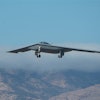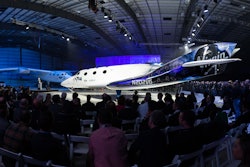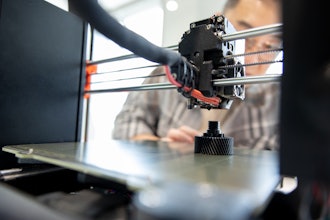NASA’s Orion Multi-Purpose Crew Vehicle (MPCV) is a spacecraft planned to take astronauts farther than any human has ever gone before. The agency launched the spacecraft on its first test flight in December 2014, and NASA hopes to launch Orion on a crewed mission beyond low Earth orbit in 2021.
Although somewhat similar to the Apollo spacecraft in shape and appearance, Orion is larger and can fit up to six crew members at once, compared to Apollo’s three. In addition, a new version of the Apollo heat shield will keep the astronauts safe as the crew module re-enters Earth’s atmosphere when it returns from deep space.
“It’s being built for multiple destinations,” explains Lara Kearney, Deputy Manager of the Orion Crew and Service Module. “We want it to be flexible in its ability to go different places, whether it be just beyond the lunar orbit or to an asteroid.”
Orion is being developed simultaneously with NASA’s Space Launch System (SLS), a heavy-lift rocket, which will be capable of sending humans to deep space destinations and eventually Mars.
The first mission to integrate Orion and the SLS, Exploration Mission-1 (EM-1), will take place in the fall of 2018. The Orion spacecraft will travel thousands of miles beyond the moon over the course of about a three-week mission.
A Second Chance
The Orion MPCV was announced by NASA on May 24, 2011, but its design was actually based on the Orion Crew Exploration Vehicle from the cancelled Constellation program.
The Constellation program, which lasted from 2005 to early 2010, had three major goals: complete the International Space Station, return to the Moon no later than 2020, and launch a crewed flight to Mars.
“However, when the administration changed, President Obama came up with a different vision,” explains Kearney, “and Orion was one of the pieces of the Constellation architecture that was maintained within the agency.”
Currently, the Orion program is following a phased approach to the spacecraft’s development, in which NASA flies two test flights with increasing capabilities on board before the first crewed flight occurs.
The first test flight, known as Exploration Flight Test-1 (EFT-1), took place on Dec. 5, 2014. Orion was launched atop a United Launch Alliance Delta IV Heavy rocket from Cape Canaveral Air Force Station’s Space Launch Complex 37 and soared approximately 3,600 miles in altitude before splashing down in the Pacific Ocean.
“[Orion] flew extraordinarily well in 2014. It was a great test flight for us, because it was only four-and-a-half hours, which meant we as a team could all sit and watch the performance of the vehicle as the mission was going on,” says Kearney.
The test flight evaluated launch and high speed re-entry systems, such as avionics, attitude control, parachutes, and the heat shield.
Plus, because EFT-1 was heavily instrumented with 1,200 sensors, NASA’s engineers were able to evaluate the data collected from the first test flight, compare it to their original predicted models, and put the data back into the design and engineering of the next test flight to optimize the vehicle.
In fact, the Orion team is already past the bulk of the engineering for the EM-1 test flight in 2018, and they’re currently moving into the manufacturing and assembly process.
“We just shipped the primary pressure vessel down to Kennedy Space Center, where the spacecraft will be assembled,” explains Kearney. “All the major components that will be assembled onto the spacecraft are set to show up this spring.”
Design & Development
By the time the Constellation program was cancelled in 2010, NASA had already spent $5 billion on developing Orion, and Lockheed Martin (the prime contractor for the spacecraft) had been working on the project for about six years.
However, in May 2011, NASA announced that the Orion spacecraft would be “repurposed” to develop and construct the MPCV.
Lockheed Martin is still responsible for the overall integration of the spacecraft, but the aerospace company also has an industry team, which includes major subcontractors Aerojet Rocketdyne, United Technologies Aerospace Systems, and Honeywell, as well as minor subcontractors in 45 states nationwide.
“Orion is made up of three major systems,” says Kearney. “We have the launch abort system, which can actually pull the crew module away from the rocket if we find ourselves in trouble with the rocket either on the launch pad or on the way up.
“Then we have the crew module, which is what most people recognize based on Apollo, which actually lands with the crew. And finally, we have the service module, a cylindrical piece that is staged underneath the crew module, and it actually flies with us for the majority of the mission. That service module is where all the consumables are housed.”
Because Orion is designed to be a deep space exploration vehicle, mass is more critically important to the spacecraft’s design than if it were just going out into low Earth orbit.
“The farther you’re going, the more mass you have to push, and the more critical mass becomes,” explains Kearney. “So we have to do a lot of systems analysis up front based on mission objectives, such as where we’re going and how long we’re going to be there.”
The spacecraft is being designed for four crewed 21-day missions, so NASA will have to size all the components of the mission to meet that criteria, including oxygen tanks, consumables, nitrogen, and propulsion systems.
Learning from Experience
Although EFT-1 was largely a success, the Orion team did discover some areas for improvement on the spacecraft.
“I would say that one of the biggest challenges so far, through EFT-1 and EM-1 both, is the heat shield,” says Kearney. “Orion has the largest heat shield ever built. It’s about 15-meters in diameter, and being a deep space vehicle, it will have an entry speed well beyond anything you’d see coming in from low Earth orbit.”
During EFT-1, Orion came close to 17,000 mph upon re-entry into Earth’s atmosphere, and it will be traveling at more than 20,000 mph during a Mars or lunar return.
For the first test flight, engineers at Colorado-based Lockheed Martin designed the heat shield with a titanium skeleton and carbon fiber skin, which was then shipped to Textron Defense Systems in Massachusetts for installation of a fiberglass phenolic honeycomb structure.
Textron technicians filled the cells with an ablative material called Avcoat, using a special dispensing gun. The material is designed to protect the vehicle from return temperatures around 4,000°F.
“Retaining the thermal capability while making [the heat shield] as light as possible has been challenging,” remarks Kearney. “We also went through a major architecture change between the flight test a year ago and the one we’re coming up on [in 2018].”
The heat shield used during EFT-1 was a monolithic design, which has now been converted to a block architecture for EM-1. The first test flight produced some cracking at the base of the heat shield, which mostly had to do with the stress that it was under while attached to the rest of the vehicle.
The block architecture will not only eliminate some of the stress cracking, but the life-cycle cost will also be less compared to the monolithic design.
Improving Upon Apollo
Despite the fact that the Apollo missions had much larger budgets than today’s spaceflight programs, NASA currently has the benefit of advanced computer modeling.
“We model nearly everything, from the electronics to fluid systems and mechanical systems,” says Kearney. “And we anchor those models primarily on ground based testing so we can get confidence in [them].”
Due to the modeling and assessments from the first test flight, the Orion MPCV will be considerably lighter during EM-1 than it was during its maiden voyage. The weight loss is the result of a reduction in the number of the pressure vessel’s cone panels and welds, in addition to a loss of 1,200 pounds from Orion’s thermal protection system. Once completed, the crew module will be about 4,000 pounds lighter than it was during EFT-1.
The test flights, reengineering, and upgrades will ultimately lead to Orion’s 2021 crewed mission. Although the exact destination is not yet planned, the spacecraft will take humans farther than they have every gone before, whether it be an asteroid mission, a distant retrograde lunar orbit mission, or eventually Mars.
“We look back at the Apollo missions from the 1960s and 70s, and it was the next big step,” says Kearney. “I hope Orion and SLS are the next big steps in human exploration beyond low Earth orbit. The vehicle will be able to go farther and stay longer than we’ve ever been able to go before, and that really is the next step to be able to go to Mars.”
This article originally appeared in the March 2016 issue of Product Design & Development.






















